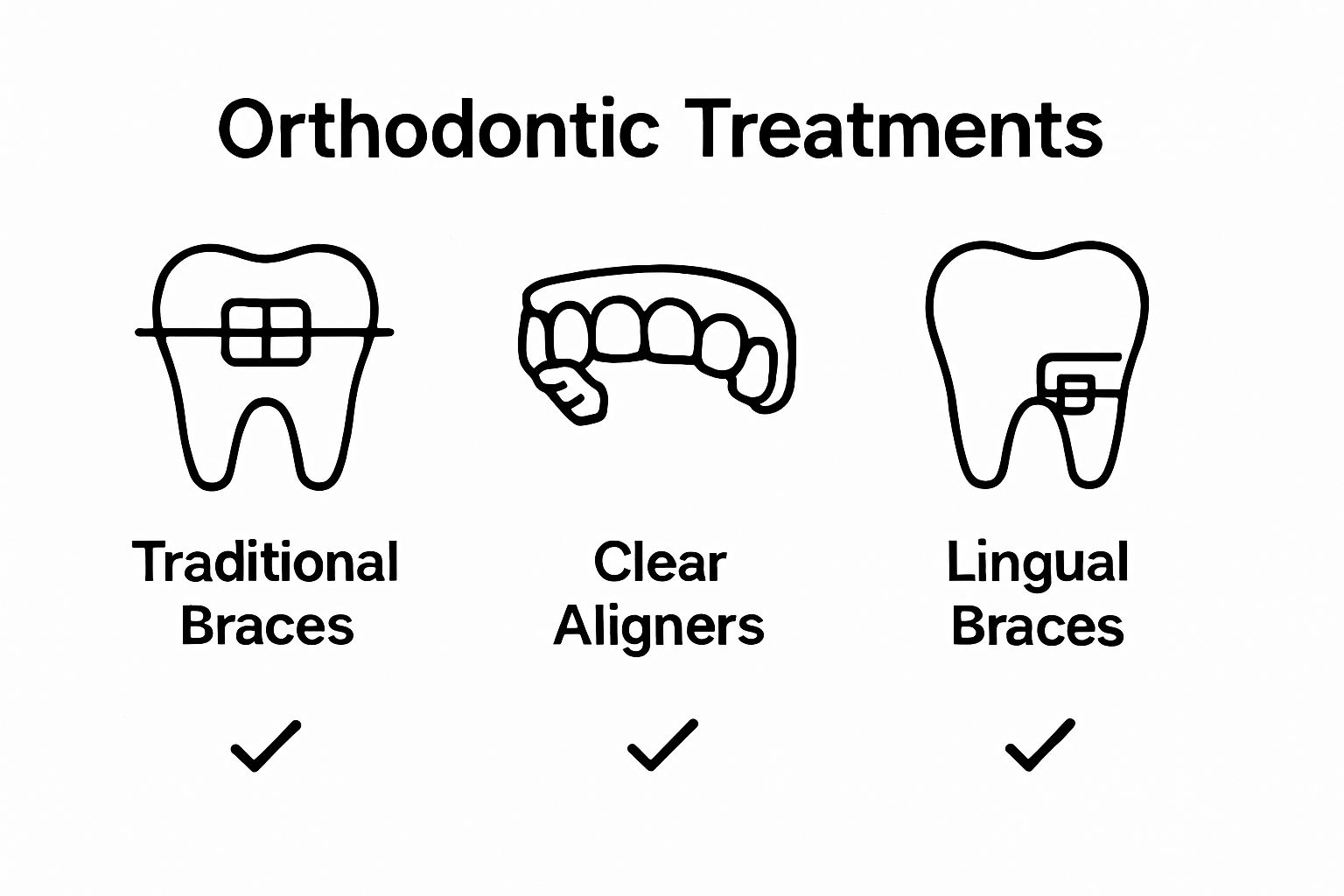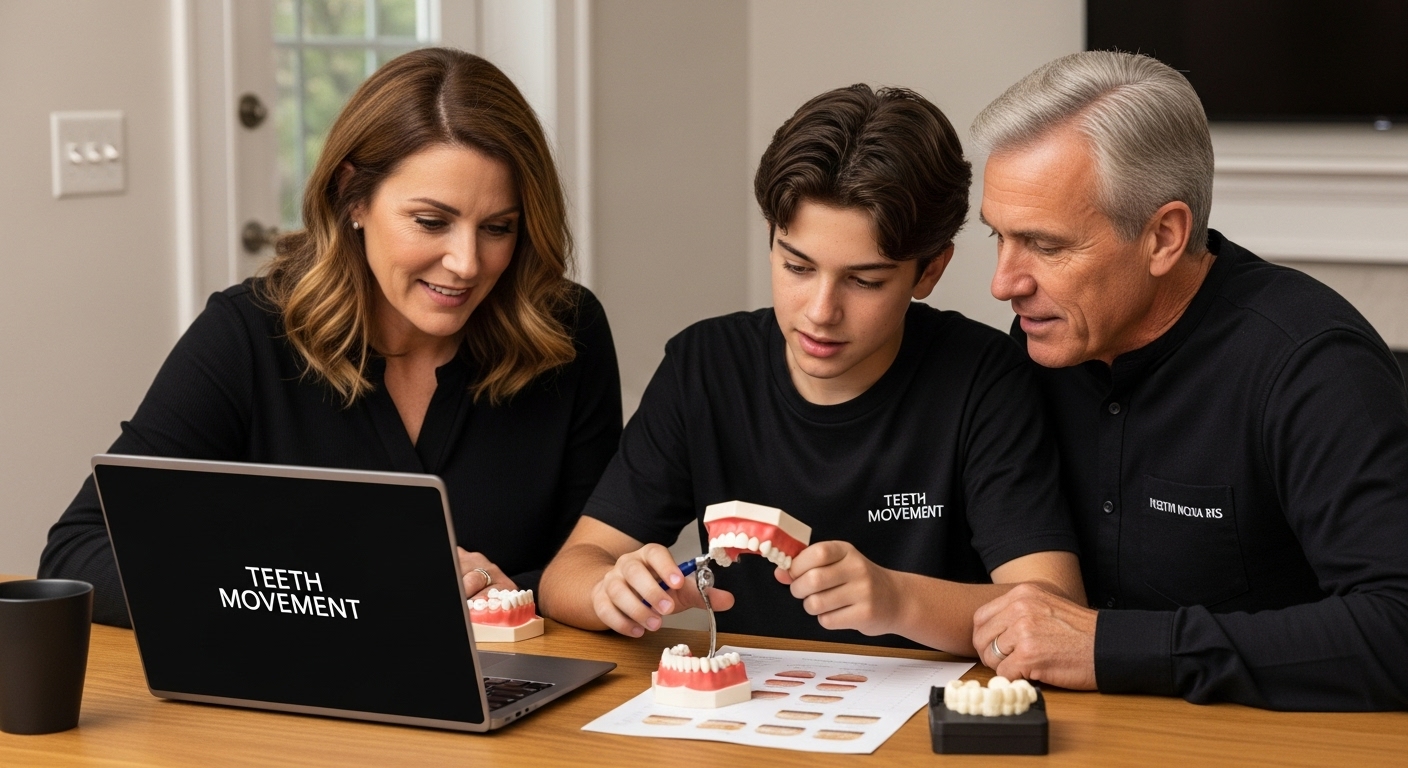Understanding How Teeth Move: The Science Explained
September 19, 2025
Understanding How Teeth Move: The Science Explained
Teeth do so much more than just help you chew your favorite food. They are made of multiple layers and contain the hardest material in the human body—enamel is even tougher than bone. Most people think teeth are pretty basic, but their real job list is surprisingly long. They secretly shape the way you talk, help you digest food, and even keep your face looking the way it does.
Table of Contents
- What Are Teeth And Their Roles In Oral Health
- Why Is Understanding Tooth Movement Important For Orthodontics
- How Do The Biological Processes Facilitate Teeth Movement
- What Are The Types Of Orthodontic Treatments That Promote Tooth Movement
- How Can Families Select The Best Options For Teeth Movement
Quick Summary
| Takeaway | Explanation |
|---|---|
| Teeth are crucial for health | Beyond chewing, teeth help with digestion, speech, and facial structure support. |
| Proper care prevents oral issues | Regular dental hygiene avoids decay, misalignment, and systemic health problems. |
| Tooth movement involves biology | Orthodontics utilizes bone remodeling and cellular interactions to reposition teeth. |
| Customized orthodontic treatment is essential | Individual factors require tailored treatment plans for effective orthodontic outcomes. |
| Professional assessment guides treatment choice | Comprehensive evaluations help families choose the best orthodontic options based on needs and preferences. |
What Are Teeth and Their Roles in Oral Health
Teeth are complex biological structures that play critical roles far beyond simply chewing food. Composed of multiple layers and unique mineralized tissues, these remarkable structures are fundamental to human health and functionality.
Anatomy of Teeth
Each tooth consists of several distinct layers that work together to perform essential functions. The outermost layer, enamel, is the hardest substance in the human body – even stronger than bone. This protective white coating shields the inner tooth structures from damage and bacterial invasion. Beneath the enamel lies dentin, a softer tissue that provides structural support and contains microscopic tubules connected to nerve endings.
At the tooth’s core is the pulp, a soft tissue containing blood vessels, nerves, and connective tissue. This living component supplies nutrients and sensory information, enabling teeth to respond to temperature changes and potential damage.
Functional Roles in Human Health
Teeth serve multiple critical functions beyond basic eating:
- Digestion: Breaking down food into smaller particles, initiating the digestive process
- Speech Production: Helping form specific sounds and articulate words
- Facial Structure Support: Maintaining jaw alignment and preventing facial muscle collapse
According to National Institute of Dental and Craniofacial Research, teeth are essential not just for eating, but for overall physiological functioning. They contribute to nutrition, communication, and maintaining facial aesthetics.
Proper dental care ensures these remarkable biological tools remain healthy, preventing issues like decay, misalignment, and potential systemic health complications. Understanding teeth goes beyond seeing them as simple chewing tools – they are intricate, living components of our complex human biology.
Why is Understanding Tooth Movement Important for Orthodontics
Orthodontics is a specialized field of dentistry that goes far beyond simple aesthetic improvements. Understanding how teeth move requires complex knowledge of biological mechanisms, biomechanical principles, and individual patient variations.
Biological Mechanisms of Tooth Movement
Tooth movement is not a simple mechanical process but a sophisticated biological response involving multiple cellular interactions. When orthodontic forces are applied, complex bone remodeling occurs around the tooth root. Specialized cells called osteoclasts break down bone tissue on the pressure side, while osteoblasts simultaneously build new bone on the tension side. This delicate balance allows teeth to shift gradually and safely within the jaw.
Personalized Treatment Considerations
Every patient’s tooth movement is unique, influenced by factors such as:
- Age and bone density
- Genetic predisposition
- Existing dental structure
- Overall health conditions
- Metabolic rate
These individual variations mean that orthodontic treatment cannot follow a one-size-fits-all approach. Precise understanding of tooth movement allows orthodontists to create customized treatment plans that minimize risks and maximize effectiveness.
According to International Journal of Orthodontics, understanding the biological basis of tooth movement is critical for safe and effective orthodontic interventions. Clinicians must consider how different forces impact tooth roots, surrounding tissues, and overall oral health.
Ultimately, comprehending tooth movement transforms orthodontics from a mechanical procedure into a nuanced, patient-centered healthcare approach that respects the complexity of human biological systems.
How do the Biological Processes Facilitate Teeth Movement
Teeth movement is a sophisticated biological phenomenon involving intricate cellular interactions and complex physiological responses. Unlike simple mechanical displacement, tooth movement represents a dynamic process of tissue adaptation and reconstruction.
Cellular Response Mechanisms
When orthodontic forces are applied, an immediate biological cascade begins within the periodontal ligament. Specialized cells recognize mechanical stress and trigger a remarkable series of coordinated responses. Mechanoreceptors in the periodontal ligament detect applied force, initiating a signaling process that recruits bone remodeling cells.
Bone Remodeling Dynamics
The bone remodeling process involves two primary cellular actors:
- Osteoclasts: Cells responsible for bone tissue breakdown
- Osteoblasts: Cells responsible for new bone formation
- Periodontal ligament cells: Coordinate cellular communication
On the pressure side of the tooth, osteoclasts begin breaking down bone tissue, creating space for tooth movement.
Simultaneously, on the tension side, osteoblasts deposit new bone material, stabilizing the tooth in its emerging position.
According to Journal of Dental Research, this intricate process is not just mechanical but a complex biochemical event involving cytokines, prostaglandins, and growth factors. These molecular signals orchestrate a precise, controlled transformation of bone and soft tissue.
The biological processes underlying tooth movement demonstrate the remarkable adaptability of human physiology. What appears to be a simple repositioning of teeth is actually a testament to the body’s incredible capacity for precise, controlled biological transformation.
What are the Types of Orthodontic Treatments that Promote Tooth Movement
Orthodontic treatments represent a sophisticated approach to guiding teeth into optimal alignment. These interventions utilize different mechanisms to facilitate controlled, precise tooth movement tailored to individual patient needs.
Traditional Orthodontic Appliances
Braces remain the most common and versatile method for promoting tooth movement. Metal or ceramic brackets are attached directly to teeth, connected by wires that apply consistent, carefully calculated pressure. These appliances enable orthodontists to manipulate tooth position through incremental adjustments, allowing gradual and controlled repositioning.
Modern Alignment Technologies
Contemporary orthodontic treatments offer multiple innovative options:
- Clear Aligners: Removable, transparent plastic trays that incrementally shift teeth
- Lingual Braces: Brackets placed behind teeth for invisible treatment
- Self-Ligating Braces: Advanced brackets reducing friction and accelerating movement
Each technology provides unique advantages in promoting tooth movement while addressing patient comfort and aesthetic preferences.
Below is a comparison table summarizing the different types of orthodontic treatments and their key characteristics, helping readers easily see their options and main differences.
| Treatment Type | Visibility | Removability | Key Advantages |
|---|---|---|---|
| Traditional Braces | Noticeable (metal/ceramic) | Fixed | Versatile, effective for complex cases |
| Clear Aligners | Nearly invisible | Removable | Aesthetic, better hygiene, comfortable |
| Lingual Braces | Hidden behind teeth | Fixed | Discreet, suited for aesthetic-conscious patients |
| Self-Ligating Braces | Less noticeable | Fixed | Reduced friction, may speed up treatment |
 Clear aligners, for instance, offer near-invisibility and improved hygiene compared to traditional braces.
Clear aligners, for instance, offer near-invisibility and improved hygiene compared to traditional braces.
According to Orthodontic Research Journal, modern orthodontic treatments can be categorized into conservative and surgical approaches. These methods aim to optimize tooth movement efficiency while minimizing treatment duration and patient discomfort.
The evolution of orthodontic treatments reflects a profound understanding of biomechanical principles and patient-centered care. By offering diverse options, orthodontists can now create personalized treatment plans that respect individual anatomical variations and aesthetic goals.
How can Families Select the Best Options for Teeth Movement
Selecting the most appropriate orthodontic treatment requires thoughtful consideration of multiple factors. Families must navigate a complex landscape of technological options, individual health needs, and long-term dental goals.
Comprehensive Professional Assessment
The foundation of selecting the right teeth movement treatment begins with a thorough professional evaluation. Orthodontic specialists conduct comprehensive examinations that go beyond visual inspection. These assessments typically include digital imaging, 3D scans, and detailed analysis of jaw alignment, bite mechanics, and individual tooth positioning.
Key Consideration Factors
Families should evaluate several critical elements when choosing an orthodontic approach:
- Age and Dental Development: Different treatments suit different growth stages
- Complexity of Dental Misalignment: Severity determines treatment options
- Lifestyle and Aesthetic Preferences: Visibility of treatment matters
- Budget and Insurance Coverage: Financial considerations are crucial
- Treatment Duration: Estimated time commitment varies by method
Personal and Genetic Factors
Individual biological responses play a significant role in treatment success. Genetic predispositions, bone density, and metabolic rates can influence how quickly and effectively teeth move. Some patients respond more rapidly to orthodontic interventions, while others require more extended, nuanced approaches.
According to Orthodontic Biomechanics Research, evidence-based planning and comprehensive clinical assessment are paramount in selecting the most effective teeth movement strategy. Families should prioritize professional guidance and personalized treatment planning over generic approaches.

Ultimately, the best teeth movement option emerges from a collaborative dialogue between orthodontic professionals and patients, balancing clinical expertise with individual needs and preferences.
Experience the Science of Confident Smiles at Glow Orthodontics
Understanding how teeth move involves more than just biology — it addresses real concerns like discomfort, treatment length, and choosing the right orthodontic solution. Many patients worry whether their treatment plan fits their unique needs. If you’re seeking an expert team who truly understands tooth movement, Glow Orthodontics transforms complex scientific principles into personalized, gentle care.

Don’t let uncertainty about orthodontic options hold your family back. Discover how our personalized Invisalign and braces treatments use evidence-based methods to guide teeth with precision, comfort, and predictability. Book your consultation today through our easy online system. Find out how we turn advanced science into glowing, healthy smiles for every patient. Take the first step to the confident results you deserve — visit Glow Orthodontics now.
Frequently Asked Questions
What biological processes facilitate tooth movement during orthodontic treatment?
Tooth movement involves a biological cascade within the periodontal ligament, including responses from mechanoreceptors that detect force and trigger recruiting signals for bone remodeling. Specialized cells called osteoclasts break down bone tissue on the pressure side, while osteoblasts build new bone on the tension side.
How do orthodontic appliances differ in promoting tooth movement?
Orthodontic appliances, such as traditional braces, clear aligners, and lingual braces, utilize varying mechanisms to promote tooth movement. Braces use brackets and wires for controlled pressure, while clear aligners offer a removable option for gradual adjustments, and lingual braces are placed behind teeth for a discreet solution.
Why is personalized treatment important in orthodontics?
Personalized treatment is crucial because each patient’s tooth movement is influenced by unique factors such as age, existing dental structure, and overall health. Customizing treatment plans can minimize risks and enhance the effectiveness of the orthodontic intervention.
What factors should families consider when selecting orthodontic treatments?
Families should consider several factors, including the child’s age and dental development, the severity of misalignment, lifestyle and aesthetic preferences, budget and insurance coverage, and the estimated duration of treatment. These elements help ensure an appropriate and effective orthodontic approach.